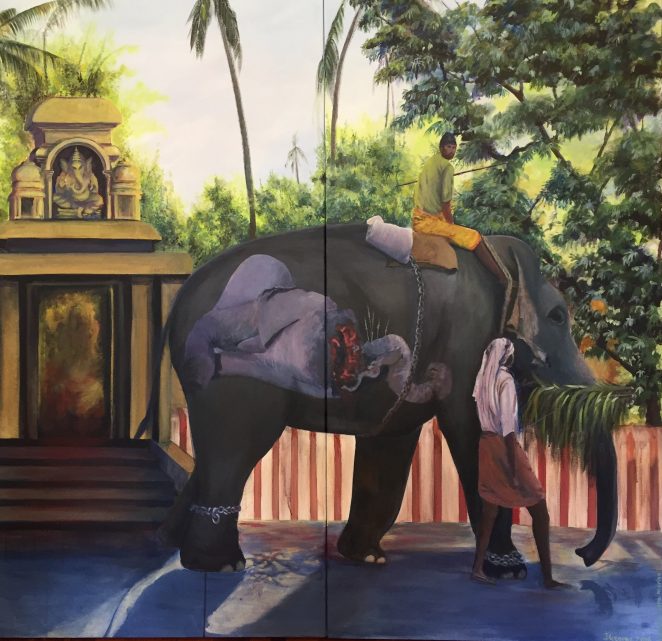March 11, 2020
Tell us about yourself
 I am an Assistant Professor in the Art Therapy Counseling Program at Southern Illinois University Edwardsville (SIUE). I have doctoral and master’s degrees in Art Therapy (DA & MA) from New York University and SIUE, respectively, and a master’s degree (MS) in Marriage and Family Therapy from Kansas State University. An anti-oppression stance is a key part of my clinical, artistic and scholarly work. Most recently I am working in a private practice in Emporia, KS serving individuals, couples and families, some of whom are survivors of domestic violence. I am a former Chair of the Multicultural Committee and served on the Educational and Program Approval Board. I have, in the past, typically been involved with local chapters such as serving as President of the Northern California Art Therapy Association.
I am an Assistant Professor in the Art Therapy Counseling Program at Southern Illinois University Edwardsville (SIUE). I have doctoral and master’s degrees in Art Therapy (DA & MA) from New York University and SIUE, respectively, and a master’s degree (MS) in Marriage and Family Therapy from Kansas State University. An anti-oppression stance is a key part of my clinical, artistic and scholarly work. Most recently I am working in a private practice in Emporia, KS serving individuals, couples and families, some of whom are survivors of domestic violence. I am a former Chair of the Multicultural Committee and served on the Educational and Program Approval Board. I have, in the past, typically been involved with local chapters such as serving as President of the Northern California Art Therapy Association.
What excites (or inspires) you most about your job right now?
I love teaching. I have most recently completed my training as a Somatic Experiencing Practitioner. As a treatment for trauma, it has profoundly influenced my work with individuals, couples and families. I am in the process of integrating my studies in couples and family therapy, domestic violence and trauma treatment into my pedagogy. Also, I have just begun work as a mental health consultant with Head Start for home-based family work. Practice has always informed my teaching and I am hoping it continues to do so.
Has working with a particular client group shaped your professional focus or specialty? What have you learned from working with these clients?
Looking over my most recent professional work, I have worked with survivors of domestic violence, mostly with Latina women with the help of an interpreter. I have also worked with couples and look forward to honing this as a second niche area. Cultural differences and similarities interest me. Putting together attachment theory, mindfulness, trauma work that are based in neuroscience, all nested within socio-cultural contexts is like piecing together a mosaic or a quilt. The clients get to re-author their lives and I get to co-create as I go along on the journey of therapy. The clients teach me humility.
What advice would you give someone interested in pursuing a career in art therapy?
We are wounded healers. That said, I take psychology’s exhortation of “Know thyself” seriously. Attending to one’s own need for healing needs to precede careers in the healing professions which demand much maturity. And here, I am uncoupling maturity from chronological age. Similarly, a deep understanding of the artistic process and expression does contribute to an enriching art therapy career. As art therapists, I believe we are the stewards of creativity. The more we own it, the better off the field.
What are your hopes for the future of the art therapy profession?
The practice of art therapy has had a profound influence on my life. Getting in touch with the philosophy of creativity and healing has made me a confident practitioner. And there is work to be done. A deep understanding of the actual meaning of social justice is much needed, as in the structural nature of oppression. Without this, we will only be paying lip service to the idea of cultural competence. I hope that we own our stewardship of creativity more than we do currently.
Is there anything else you would like to share?
My current art involves heeding a self-imposed pledge to paint 108 elephants in a move to agitate against the poaching of elephants in Asia and Africa. I have also pledged to donate 50% of the proceeds towards anti-poaching efforts.

“And Ganesha looks on…” by Jayashree George. Acrylic on Canvas.
Artist statement: “In India, elephants are often painted and used for ceremonial purposes, often in abusive conditions. In this painting, I offer that if elephants were to paint on themselves, they might offer protest art, such as “don’t kill us.” This elephant has that message as Ganesha, the elephant headed god, looks on.”
